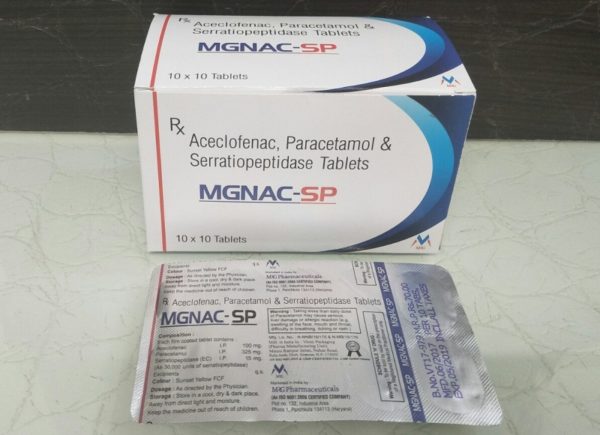MG NAC-SP
COMPOSITION: ACECLOFENAC 100 MG + PARACETAMOL 325 MG + SERRATIOPEPTIDASE 15 MG
- Reviews (0)
- Indications
- Product Description
Be the first to review “MG NAC-SP”
PAIN, INFLAMATION & OEDEMA
Aceclofenac
is a non-steroidal anti-inflammatory drug (NSAID) analog of Diclofenac. It is used for the relief of pain and inflammation in rheumatoid arthritis, osteoarthritis and ankylosing spondylitis. The dose is 100 mg twice daily.
It should not be given to people with porphyria or breast-feeding mothers, and is not recommended for children.
Aceclofenac has higher anti-inflammatory action than conventional NSAIDs. It is a cytokine inhibitor. Aceclofenac works by blocking the action of a substance in the body called cyclo-oxygenase. Cyclo-oxygenase is involved in the production of prostaglandins(chemicals in the body) which cause pain, swelling and inflammation. Aceclofenac is the glycolic acid ester of diclofenac.
Paracetamol
Is a pain reliever and a fever reducer.
Paracetamol is used to treat many conditions such as headache, muscle aches, arthritis, backache, toothaches, colds, and fevers.
Serratiopeptidase
Is a proteolytic enzyme isolated from the micro-organism Serratia E15. This enzyme is naturally processed commercially today through fermentation and was discovered in the silkworm intestine. This immunologically active enzyme is completely bound to the alpha 2 macroglobulin in biological fluids. Serrapeptase digests non-living tissue, blood clots, cysts, and arterial plaque and inflammation in all forms.
Pharmacokinetics
Aceclofenac is a phenylacetic acid derivative that inhibits synthesis of the inflammatory cytokines interleukin-1b and tumour necrosis factor, and inhibits prostaglandin E2 production. It increases glycosaminoglycans (GAG) synthesis, the principal macromolecule of the extracellular matrix, which aids in repair and regeneration of articular cartilage. Thus, aceclofenac has ve effects on cartilage anabolism combined with modulating effect of matrix catabolism. Paracetamol has analgesic and antipyretic action with weak anti-inflammatory activity. It produces analgesia by increasing pain threshold and antipyresis by acting on the hypothalamic heat-regulating centre.
Absorption
Aceclofenac: Rapidly absorbed; almost 100% bioavailability; peak plasma levels reached about 1.25-3 hours after oral admin.
Distribution
Aceclofenac: >99.7% bound to plasma proteins; distributes into synovial fluid. Paracetamol: Distributes throughout most fluids of the body.
Metabolism
Aceclofenac: Probably metabolised by CYP2C9; average plasma elimination half-life: 4-4.3 hours. Paracetamol: Mainly metabolised hepatically; plasma elimination half-life: 1-4 hours.
Excretion
Aceclofenac: About two-thirds of the administered dose is removed in the urine, mainly as conjugated hydroxymetabolites. Paracetamol: Most metabolites are removed in the urine within 24 hours.
Aceclofenac Paracetamol Serratiopeptidase Side Effects
Paracetamol: Nausea, allergic reactions, skin rashes, acute renal tubular necrosis. Aceclofenac: Diarrhoea, headache, vertigo, dizzies, nervousness, tinnitus, depression, drowsiness, insomnia; fever, angioedema, bronchospasm, rashes; blood dyscrasias.
Potentially Fatal: Paracetamol: Very rare, blood dyscrasias (eg, thrombocytopaenia, leucopaenia, neutropaenia, agranulocytosis); liver damage. Aceclofenac: Severe GI bleeding; nephrotoxicity.
Special Precautions
GI disease; renal or hepatic impairment; alcohol-dependent patients; asthma or allergic disorders; haemorrhagic disorders; hypertension; cardiac impairment. Elderly. Caution when driving or operating machinery. Monitor renal and hepatic function and blood counts during long term treatment. Persistently elevated hepatic enzyme levels may require drug withdrawal. Pregnancy, lactation.
Other Drug Interactions
Paracetamol: Reduced absorption of cholestyramine within 1 hour of administration. Accelerated absorption with metoclopramide. Aceclofenac: M0ay increase the plasma concentrations of lithium and digoxin. Increased nephrotoxicity with diuretics. Serum-potassium should be monitored when used with potassium-sparing diuretics. May enhance activity of anticoagulants. May increase plasma methotrexate levels leading to toxicity if administered within 2-4 hours of methotrexate admin. Risk of convulsions with quinolones.
Potentially Fatal: Paracetamol: Increased risk of liver damage in chronic alcoholics. Increased risk of toxicity with high doses or long term admin of barbiturates, carbamazepine, hydantoins, isoniazid, rifampin and sulfinpyrazone.






Reviews
There are no reviews yet.